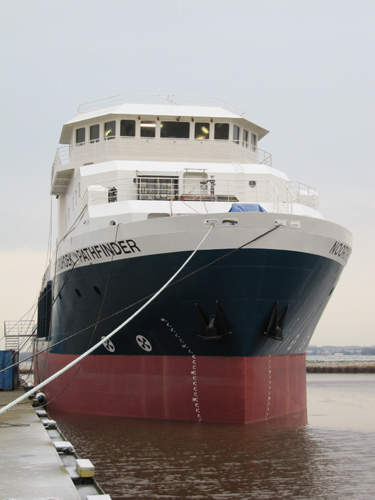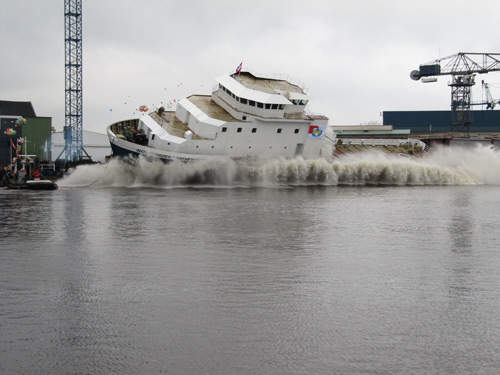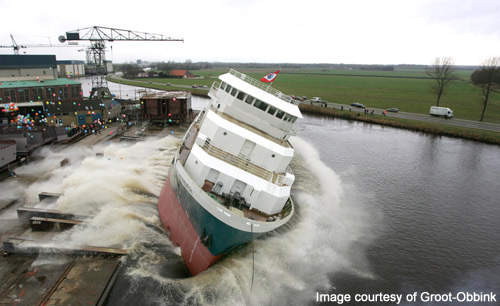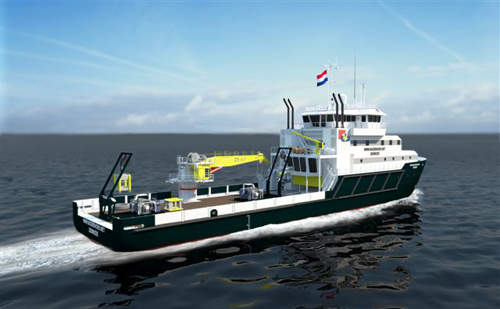The Noordhoek Pathfinder is a DPII remotely operated vehicle (ROV) and survey support vessel being built by De Hoop Shipyard for the Netherlands-based Noordhoek Survey BV. It will be Noordhoek’s third vessel and its first ROV survey offshore vessel. The ROV is scheduled to be delivered in the first quarter of 2010.
The Pathfinder will carry out geo-technical investigations, hydrography, and analogue and digital geophysical surveys. It will also be able to carry out inspection, repair and maintenance. The vessel will be constructed in accordance with the latest environmental and acoustic standards to ensure quiet operations at survey speeds.
The 1,500mt Pathfinder will have an overall length of 61.9m, a breadth of 12.8m and a moulded depth of 5.5m. The vessel has an economical speed of 12kt and a service speed of 14kt.
Construction
The shipbuilding contract was awarded to De Hoop Shipyard in October 2008. The keel was laid in December and the vessel launched in November 2009. The super structure sections were installed in September 2009.
Final fitting will see the installation and commissioning of crane and survey spread prior to the beginning of sea trials.
Equipment and systems
The Pathfinder will be equipped with a Grade 2 Dynamic Positioning system (DPII), a diesel electric drive system, a moon pool and a 25t offshore crane. It will also be fitted with work-class and inspection-class ROV systems, side scan sonar tow fish, McCartney Focus 2 ROTV systems and an advanced survey suite. It will be equipped with modern survey equipment and full plug-and-play interconnectivity.
The DPII system will be controlled by a computer that automatically manages the position and direction of the ship through its propellers and thrusters. The system is supported by reference systems including DGPS position, gyro compasses, an ultra-short base line system, vertical reference units and wind sensors.
The Pathfinder will have one work-class ROV and one inspection-class ROV. In addition, two remotely operated towed vehicles will also be available on board.
The ship will have a tank capacity of 600m3 fuel oil, 150m3 of fresh water, 400m3 of ballast water and 8m3 of lubricant oil. It will also have provisions to produce 7.5mt of fresh water in 24 hours.
Navigation and communications
The vessel’s navigation suite will comprise a magnetic compass, a radar with a 12ft scanner operating on S-band, and a radar with a 6.5ft scanner. The other supporting systems include a NAVTEX system, echosounder and Doppler log for water and bottom tracking.
Communications is enabled through an Inmarsat Satcom C satellite system, an F33 satellite communication terminal and a two-way satellite ground station. The communication equipment includes a MF/HF transceiver and controller, two rador responders and VHF radio transceiver.
Accommodation
The vessel will accommodate 40 crew. The wheelhouse and rooms will be fully air conditioned and heated. Additional space will also be available for office and general purpose. A wet laboratory and workshop will be constructed over an area of 200m2.
Propulsion
The Pathfinder will be powered by four Caterpillar engines, two of which are rated at 950kW each and the other two at 500kW. Manoeuvrability is provided by a 900kW Veth thruster and a 900kW Azimuth thruster. Two forward thrusters are rated at 350kW each. Auxiliary power will be provided by a 105kW emergency generator.











